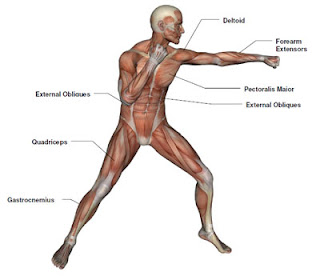Wednesday, December 15, 2010
Tuesday, December 7, 2010
 The Brooklyn site has a slope. The lot descends 12 feet over a length of about 225 feet. On the York Street end the site starts at 0'-0" and moves down 12' on the other end. I've excavated a couple spaces at different elevations until I reached -12'-0". I did make an addition which is essentially a drum from -12' to +10' which houses the main event boxing arena of the gym. The long set of stairs is what takes you from -6' to +10'. At +10' there is a spectating space to the -12' space below, the space that holds the boxing arena.
The Brooklyn site has a slope. The lot descends 12 feet over a length of about 225 feet. On the York Street end the site starts at 0'-0" and moves down 12' on the other end. I've excavated a couple spaces at different elevations until I reached -12'-0". I did make an addition which is essentially a drum from -12' to +10' which houses the main event boxing arena of the gym. The long set of stairs is what takes you from -6' to +10'. At +10' there is a spectating space to the -12' space below, the space that holds the boxing arena. Friday, October 29, 2010
3D Concept Models (continued...)
Continuing at the second part of the building, for the "impacted object", I tried to work with an image of an impact during a boxing fight.
I wanted to abstract the impact concept behind this image a little deeper. Since boxers with weak jaws are sometimes said to have "glass jaws" I looked into impacted glass.
The model of the shattering glass still needs to be worked on. Also when placing these two objects (arm and head) on the site their scale leaves about 45% more room to be occupied on the lot (length-wise).
It's in that 45% that the boxing venues will be placed. That is my next step and also giving it some program and adjsuting the design according to the spacial requirements.
I created a raw model of a curved material at the moment of impact (shattering glass).
I slightly modified the first object so that it is coming from the bottom of the slope up on the site. Here the arm impacts the head and shatters it. Materials in mind are: gray or black stone panels for the arm and clear glass for the head.
The model of the shattering glass still needs to be worked on. Also when placing these two objects (arm and head) on the site their scale leaves about 45% more room to be occupied on the lot (length-wise).
It's in that 45% that the boxing venues will be placed. That is my next step and also giving it some program and adjsuting the design according to the spacial requirements.
Friday, October 22, 2010
3D Concept Study Models
The original idea was for two objects, one that impacts the other. The idea comes from a punch and its impact, very suiting to the building type that is my gym.
To get into more detail on the form of my building I began at object one, "the arm". Since this was a specific type of punch, the jab, i observed its movement and found it has a twist. a 90 degree twist to be exact.
From this notion of the twist in the punch I arrived at my first shape. The one that would be given to the "arm" part of the building.
The next step is to create the form of the second half of the building, the "head", which receives the impact.
To get into more detail on the form of my building I began at object one, "the arm". Since this was a specific type of punch, the jab, i observed its movement and found it has a twist. a 90 degree twist to be exact.
From this notion of the twist in the punch I arrived at my first shape. The one that would be given to the "arm" part of the building.
The next step is to create the form of the second half of the building, the "head", which receives the impact.
Some images I'm working with...should be interesting.
Impact Raw Diagrams + Sketches
Raw sketches of the Impact Concept of the Front Part of the building. The form/shape of the building is from the concept of a punch and its impact on an object.
Top: Raw forms symbolizing the two components of the concept, object with force + object impacted.
Bottom: Starting to use rectilinear shapes at a general scale on the site.
Tuesday, October 12, 2010
Punching Bag Dimensions
The punching bag is a bag designed to be punched over and over. Its main purpose is to develop the punch technique, aerobic fitness and improve overall physical strength. It is known as a punch bag in the United Kingdom.
Punching Bag Size
These bags come in various sizes. The Roger Enterprises punching bag is 13” inches in diameter and 40” high. The Everlast 4214 leather speed bag measures 10 x 7 niches. The main criterion used for punching bags is the weight. Popular sizes include 80 lbs, 50 lbs, 40 lbs and 25 lbs.
Materials Used for Punching Bags
These bags are filled with different materials. The most popular choices are rags, sand, grains and other materials. There are also some punching bags that can be filled with water or air. These types of bags have an internal bladder.
Design
While the punching bag sizes differ, most of them are affixed to the ceiling or some sort of stand. The designs of the punching bag must also ensure it can take repeated blows without breaking or causing injury to the boxer. Many of them have are covered with leather. Other bags are covered with vinyl.
Other types of materials can be used, but for all their differences, they all share the capacity to withstand mildew and abrasion. For infrequent uses, canvas can be used for the bag. There are many types of punching bags that can be used. The following are just some of them.
Speed Bags
These are small bags filled with air. They are hooked at the top onto a rebound platform parallel to the floor. While the punching bag sizes are small, they help a boxer improve their hand speed. The speed bag also helps the boxer learn how to shift weight as they punch. These are also called speedballs or speedball bags.
Focus Bags / Double-end Bags
These bags are round and light. They are often hooked up to the ceiling and floor. They are constructed of semi-elastic or elastic materials. These are utilized for improving mobility and hitting.
Maize Bags
Unlike other punching bags, the maize bags are not hit with much power. They are instead used for boosting the individual’s head motion. The use of the punching bag also helps the boxer learn how to avoid getting hit.
Heavy Bags
These are the ones used for heavy hitting. These are hung from chains. Sometimes ropes are used instead. Other heavy bags used are the tower or pedestal bags. Other types of heavy bags include those with horizontal suspension from the ends. These are used for uppercuts.
The punching bag sizes to use will depend on your skill. If you are just starting out, you should commence with the light ones.
Other Bags
Standing Speed Bag
Standing Heavy Bag
Hook/Uppercut Bags
Sparring Partner
Monday, September 27, 2010
Tuesday, September 21, 2010
Monday, September 20, 2010
Subscribe to:
Comments (Atom)

















































